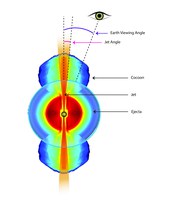Superluminal Motion of a Relativistic Jet in a Neutron Star merger
 The binary neutron-star merger GW170817 was accompanied by radiation across the electromagnetic spectrum and localized to the galaxy NGC 4993 (d ~ 41 Mpc). The radio and X-ray afterglows of GW170817 exhibited delayed onset, a gradual increase in the emission with time (proportional to t 0.8) to a peak ~150 days after the merger event, followed by a relatively rapid decline. Models have been proposed to explain the afterglow emission, including a choked-jet cocoon and a successful-jet cocoon / structured jet. However, the observational data have remained inconclusive regarding whether GW170817 launched a successful relativistic jet. Mooley et al. report radio observations acquired via Very Long Baseline Interferometry conducted with the Very Long Baseline Array, the Karl G. Jansky Very Large Array, and the Green Bank Telescope. The authors find that the compact radio source associated with GW170817 exhibits superluminal apparent motion between 75 days and 230 days after the merger event. This measurement breaks the degeneracy between the choked- and successful-jet cocoon models and indicates that, although the early-time radio emission was powered by a wide-angle outflow (a cocoon), the late-time emission was likely dominated by an energetic and narrowly collimated jet with an opening angle of less than five degrees, observed from a viewing angle of ~ 20 degrees. The imaging of a collimated relativistic outflow emerging from GW170817 adds substantial weight to the evidence linking binary neutron-star mergers and short γ-ray bursts.
The binary neutron-star merger GW170817 was accompanied by radiation across the electromagnetic spectrum and localized to the galaxy NGC 4993 (d ~ 41 Mpc). The radio and X-ray afterglows of GW170817 exhibited delayed onset, a gradual increase in the emission with time (proportional to t 0.8) to a peak ~150 days after the merger event, followed by a relatively rapid decline. Models have been proposed to explain the afterglow emission, including a choked-jet cocoon and a successful-jet cocoon / structured jet. However, the observational data have remained inconclusive regarding whether GW170817 launched a successful relativistic jet. Mooley et al. report radio observations acquired via Very Long Baseline Interferometry conducted with the Very Long Baseline Array, the Karl G. Jansky Very Large Array, and the Green Bank Telescope. The authors find that the compact radio source associated with GW170817 exhibits superluminal apparent motion between 75 days and 230 days after the merger event. This measurement breaks the degeneracy between the choked- and successful-jet cocoon models and indicates that, although the early-time radio emission was powered by a wide-angle outflow (a cocoon), the late-time emission was likely dominated by an energetic and narrowly collimated jet with an opening angle of less than five degrees, observed from a viewing angle of ~ 20 degrees. The imaging of a collimated relativistic outflow emerging from GW170817 adds substantial weight to the evidence linking binary neutron-star mergers and short γ-ray bursts.
Image: Aftermath of the merger of two neutron stars. Ejecta from an initial explosion formed a shell around the black hole formed from the merger. A jet of material propelled from a disk surrounding the black hole first interacted with the ejecta material to form a broad cocoon. Later, the jet broke through to emerge into interstellar space, where its extremely fast motion became apparent. Credit: Sophia Dagnello, NRAO/AUI/NSF
Publication: K. P. Mooley (NRAO, Caltech) et al., Superluminal motion of a relativistic jet in the neutron-star merger GW170817, Nature, 561, 355-359 (2018).




Connect with NRAO